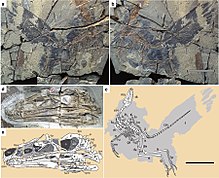Caihong
Caihong (Chinese: 彩虹; pinyin: cǎihóng; literally: "rainbow") is an extinct dinobird from Late Jurassic China. Caihong was discovered in 2014. The animal may predate the famous Aurornis xui, the earliest bird, by about 1 million years.[1]
| Caihong Temporal range: Late Jurassic,
| |
|---|---|

| |
| The holotype of Caihong juji, PMoL-B00175 | |
| Scientific classification | |
| Domain: | Eukaryota |
| Kingdom: | Animalia |
| Phylum: | Chordata |
| Clade: | Dinosauria |
| Clade: | Saurischia |
| Clade: | Theropoda |
| Family: | †Anchiornithidae |
| Genus: | †Caihong Hu et al., 2018 |
| Type species | |
| †Caihong juji Hu et al., 2018
| |
The type species, Caihong juji, was named in 2018.
Description
changeSize
changeCaihong was a rather small dinosaur. Its length was estimated at 40 cm (16 inches), and its weight at 475 g (1.047 pounds).
Skeleton
changeThe skull of Caihong has a length of 67.6 millimetres. It is low and elongated (superficially similar to that of Velociraptor), only slightly shorter than the femur.
Vertebrae
changeCaihong probably has ten neck vertebrae, thirteen back vertebrae, five sacral vertebrae and twenty-sic tail vertebrae.
Feathering and coloration
changeThe fossilized feathers of Caihong showed similarity to a black iridescent color in extant birds. Other feathers found on the head, chest, and the base of the tail preserve flattened sheets of platelet-like melanosomes.
Caihong represents the oldest known evidence of platelet-like melanosomes.
References
change- ↑ Dongyu Hu; Julia A. Clarke; Chad M. Eliason; Rui Qiu; Quanguo Li; Matthew D. Shawkey; Cuilin Zhao; Liliana D’Alba; Jinkai Jiang; Xing Xu (2018). "A bony-crested Jurassic dinosaur with evidence of iridescent plumage highlights complexity in early paravian evolution". Nature Communications. 9: Article number 217.